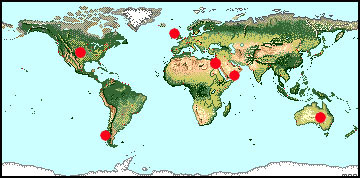|
Gary Vey
A ancient alphabet has been found Abstract
The author, in attempting to document some unusual and very old rock art in remote North America, has discovered an ancient alphabet. This alphabet is similar to ancient writing found in other locations around the globe and the author suggests that this is the result of a cultural migration. The Colorado site, located near La Junta, has been dated to before 800 BC. In the Negev desert of Israel, the same alphabet has been meticulously dated to 1500 BC. In South Australia a similar alphabet is estimated to be over 5000 years old. Other evidence has been discovered in Oklahoma, Mexico, Peru, Bolivia, Brazil and in Western Asia.

The alphabet has been given the name "old Negev," after the location of the alphabet's initial discovery in the Sinai by a Harvard funded expedition (see James Harris, Ph.D., Brigham Young University). In Australia it has been known by the name "Panaramitee Art." In the Americas it has been misrepresented as Native American Indian sign language (See LaVan Martineau, The Rocks Speak). The alphabet has most recently surfaced in Yemen, where it was carved in a beautiful font style associated with the Sabaean Empire under Bilqis, the Queen of Sheba. The alphabet is now understood to be proto-Himyaritic, or Sabaean, and has successfully been translated using the port-Canaanite algorithm. |
.
.
.
.
.
.
.
.
.
.
.
.
If you have a suggestion or history related article to submit, send it to:
Editor/viewzone.com
myristicin@hotmail.com